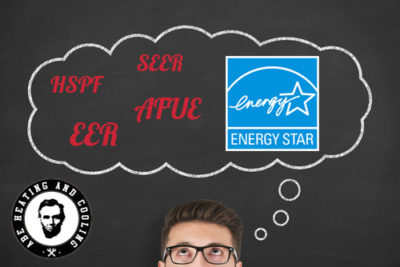“Abe's Heating and cooling were professional and on time. they helped me with two time sensitive projects and did excellent work. I know who I'll be calling if I should ever need an HVAC technician.”
Blog
 If you’ve ever shopped for a new air conditioner or furnace, you’ve probably seen energy rating data listed on the products. Knowing what those acronyms and numbers mean, and how to compare them, can save you a lot of money over the life of your HVAC equipment.
If you’ve ever shopped for a new air conditioner or furnace, you’ve probably seen energy rating data listed on the products. Knowing what those acronyms and numbers mean, and how to compare them, can save you a lot of money over the life of your HVAC equipment.
These acronyms are used frequently in the heating and cooling business, but what do they really mean?
All of these measure efficiency. The higher the efficiency rating, the greater the energy savings as less energy will be used.
There are minimum qualifications that systems must meet or exceed to be considered ENERGY STAR rated. You’ll save more money on your energy bills when you buy a system with this type of rating, but remember that ENERGY STAR rated systems also often cost a little bit more up front. You’ll make that money back in time, though, and will continue to see cost and savings benefits.
SEER and EER affect cost, and the price difference is often regional. Hotter, more humid climates may mean larger price jumps when moving from one SEER or EER rating to another, for example, because of the added work the system must do. A choice between 14 or 15 SEER may mean a difference of around $1,000, and a 21 SEER system may cost a homeowner up to 40% more than a 14 SEER system. The key is to balance the budget you have for your new system against the efficiency you’re looking for, and come to a meeting point that provides the best of both.
No matter what ratings you choose for your new system, you can take steps around the home to drive its efficiency even higher. Talk to your HVAC contractor about sealing air leaks and upgrading insulation, and be sure to have the ductwork sized when installing new equipment.
Proper installation and care for the system goes a long way toward helping it operate at peak efficiency for many years.